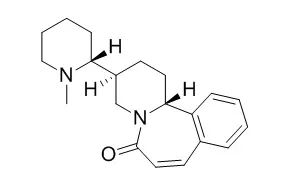| Structure Identification: |
| The Alkaloids: Chemistry and Physiology,1968,10: 545-95. | | Chapter 13 Alkaloids Unclassified and of Unknown Structure[Reference: WebLink] | This chapter discusses several plants, such as (1) Alangium lamurckii Thw., (2) Astrocasia phyllanthoides, and (3) Carduus acanthoides L., and their contained alkaloids.
METHODS AND RESULTS:
A reexamination of Alangium lamurckii Thw., has yielded tubulosine, cephaeline, and a base which seems to be protoemetinol. It was tentatively identified by its mass spectrum. Astrocasia phyllanthoides has yielded Astrocasine, C20H26ON2; monoperchlorate, and monomethiodide that have one N-methyl and a lactam carbonyl. Spectral data of it indicate a nearly planar cis-cinnamoyl N-dialkylated lactam. Catalytic reduction generates dihydroAstrocasine, C20H26ON2, and lithium aluminum hydride reduction generates oily desoxyAstrocasine that forms a dihydrochloride and a diperchlorate. Carduus acanthoides L., has mild hypotensine activity and this has been traced to one of the alkaloid constituents, acanthoidine, C16H26O2N4, B.2HCl. A second base, also isolated as its dihydrochloride was named acanthoine, C16H22O2N4, and on catalytic reduction generates acanthoidine. |
|






 Cell. 2018 Jan 11;172(1-2):249-261.e12. doi: 10.1016/j.cell.2017.12.019.IF=36.216(2019)
Cell. 2018 Jan 11;172(1-2):249-261.e12. doi: 10.1016/j.cell.2017.12.019.IF=36.216(2019) Cell Metab. 2020 Mar 3;31(3):534-548.e5. doi: 10.1016/j.cmet.2020.01.002.IF=22.415(2019)
Cell Metab. 2020 Mar 3;31(3):534-548.e5. doi: 10.1016/j.cmet.2020.01.002.IF=22.415(2019) Mol Cell. 2017 Nov 16;68(4):673-685.e6. doi: 10.1016/j.molcel.2017.10.022.IF=14.548(2019)
Mol Cell. 2017 Nov 16;68(4):673-685.e6. doi: 10.1016/j.molcel.2017.10.022.IF=14.548(2019)